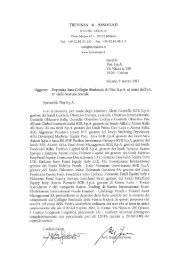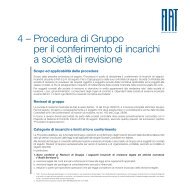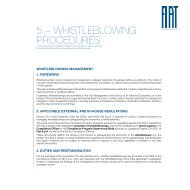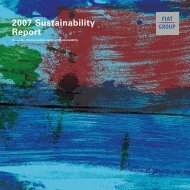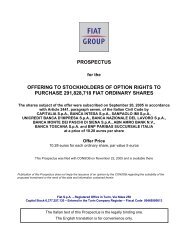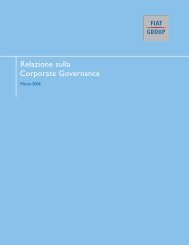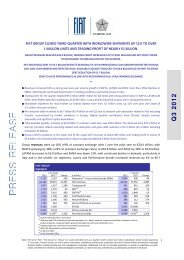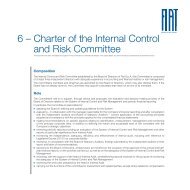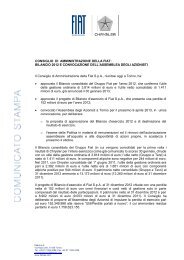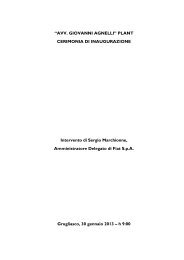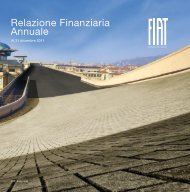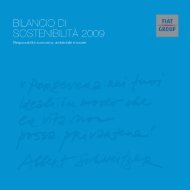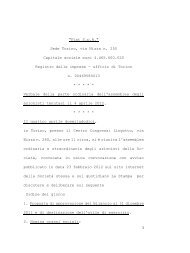annual report - FIAT SpA
annual report - FIAT SpA
annual report - FIAT SpA
Create successful ePaper yourself
Turn your PDF publications into a flip-book with our unique Google optimized e-Paper software.
In the Comau sector, the sensitivity analysis was carried out on the residual goodwill, which is mainly allocated to the<br />
Pico cash-generating unit, but no matters arose to indicate that this may be significantly impaired.<br />
The results obtained for the other sectors and related sensitivity analyses also confirmed the absence of significant<br />
impairment losses.<br />
Goodwill classified as Discontinued Operations<br />
The vast majority of goodwill classified as Discontinued Operations, representing approximately 97% of the total<br />
classified as Discontinued Operations and amounting to €1,794 million, relates to the Agricultural and Construction<br />
Equipment sector, where the cash-generating units considered for the testing of the recoverability of the goodwill are<br />
generally the product lines of the sectors themselves.<br />
The recoverable amount of the cash-generating units to which goodwill and other intangible assets with an indefinite<br />
useful life have been allocated is determined on the basis of their value in use, defined as the discounted value of the<br />
expected future operating cash flows at a rate of return that incorporates the risks associated with the particular cashgenerating<br />
units as of the valuation date. The discounted cash flows approach is dependent on several critical<br />
management assumptions, including estimates of future sales growth, gross margins, operating costs, terminal value<br />
growth rates, capital expenditures, changes in working capital requirements and the weighted average cost of capital<br />
(discount rate). More in particular, from 2006 to 2009, the Agricultural and Construction Equipment sector, managed<br />
its business at the brand level: Case IH and New Holland for Agricultural Equipment, Case and New Holland<br />
Construction for Construction Equipment; and Financial Services. In 2010, CNH began to manage its business at the<br />
Agricultural Equipment, Construction Equipment, and Financial Services level. The cash generating units to which<br />
goodwill has been allocated consist of the following product lines:<br />
(€ million)<br />
Amount allocated<br />
to goodwill<br />
at 31 December 2010<br />
Agricultural equipment 1,280<br />
Construction equipment 419<br />
Financial Services 95<br />
Total 1,794<br />
To determine the recoverable amount of these cash-generating units, the sector relied on discounted cash flows and,<br />
as a further method, on market multiples. In particular, the sector used the discounted cash flows approach as the<br />
primary approach for measuring the value in use of the Equipment Operations businesses, while used the total asset<br />
market multiples approach as the primary approach for measuring the fair value of the Financial Services <strong>report</strong>ing<br />
unit.<br />
Expected cash flows used under this method are developed in conjunction with the budgeting and forecasting process<br />
of the sector and represent the most likely amounts and timing of future cash flows based on the long range plan of<br />
CNH. The long range plan, which is updated <strong>annual</strong>ly and is reviewed by the senior management of CNH, includes,<br />
among other things, the expected benefits of planned manufacturing and product development actions as well as<br />
expectations regarding product pricing, market share and commodity costs, consistent with the assumptions reflected<br />
in the Fiat Group’s 2010-2014 Strategic Plan. The sector uses eight years of expected cash flows as management<br />
believes that this period generally reflects the underlying market cycles for its businesses.<br />
The discount rates used in the discounted cash flows approach are an estimate of the rate of return that a market<br />
participant would expect of each cash-generating unit. To select an appropriate rate for discounting the future<br />
earnings stream, a review was made of short-term interest rates and the yields of long-term corporate and<br />
government bonds, as well as the typical capital structure of companies in the industry. The discount rates used for<br />
each cash-generating unit were suitably increased to take account of the risk inherent in the cash flow projections, as<br />
well as the risk level that would be perceived by a market participant. Considering the above mentioned factors, the<br />
following discount rates before taxes as of 31 December 2010 were selected by CNH:<br />
2010 2009<br />
Agricultural equipment 17.0% 20.8% - 21.1%<br />
Construction equipment 17.4% 19.2%<br />
A terminal value is included at the end of the projection period used in the discounted cash flow analyses in order to<br />
reflect the remaining value that each cash-generating unit is expected to generate. The terminal value represents the<br />
present value in the last year of the projection period of all subsequent cash flows into perpetuity. The terminal value<br />
growth rate is a key assumption used in determining the terminal value as it represents the <strong>annual</strong> growth of all<br />
Fiat Group Consolidated Financial Statements at 31 December 2010 150



